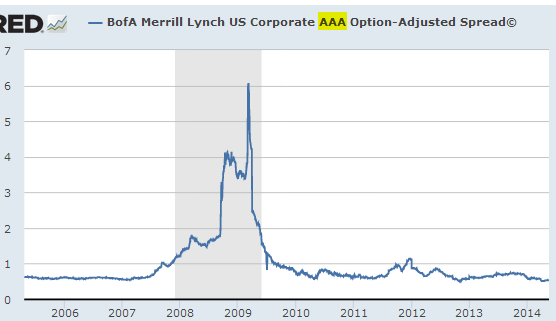Top rated investment grade US corporate bonds now trade at or even below pre-recession levels. Depending on the maturity and the type of issuer, new issue paper clears the market at spreads (to treasuries) of 30-80bp for AAA bonds.

Securitized corporate paper for similar maturities on the other hand continues to trade at a significant premium. AAA CLO bonds clear the market at 145-155 basis points spread to LIBOR – unchanged from two years ago. The two (typical) CLO deals below show that while lower rated tranches have tightened significantly (BBB for example tightened about 200 basis points over the same period), AAA spreads for standard tenor deals have not budged (and in fact are higher in some instances).

DM means effective spreadÂ
(some tranches  are issued at discount; L=”LIBOR”; source: LCD/S&P)
Some attribute this premium to higher risk of structured credit relative to single name bonds. However it is important to note that not a single AAA CLO bond lost principal through the financial crisis. The elevated spread is primarily driven by regulatory pressures and funding markets. The new FDIC rules for example penalize banks for holding these bonds (this is in addition to the Basel rules). Ironically these same rules may encourage banks to move toward riskier CLO tranches with higher yields in order to compensate for the increased FDIC charges.
Normally when there is a market dislocation such as this one, hedge funds find a way to take advantage of it. But LIBOR+150 is not yieldy enough for hedge funds and these bonds are nearly impossible to leverage in order to boost yields. So hedge funds and others in search of yield stick to the lower-rated tranches. Non-US participants, in particular yield-starved Japanese institutional investors, have been the only consistent buyers of AAA CLO paper recently. This makes the primary market vulnerable to disruptions if these investors decide to exit.

